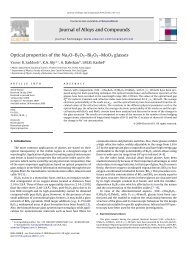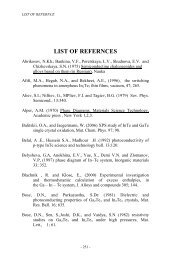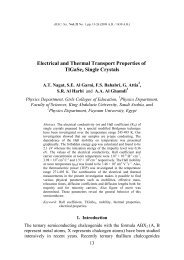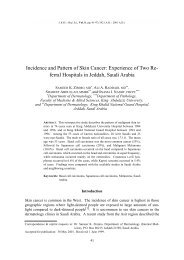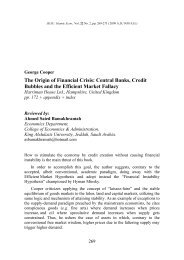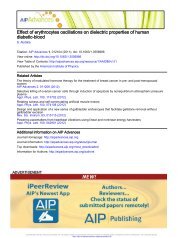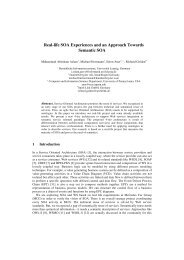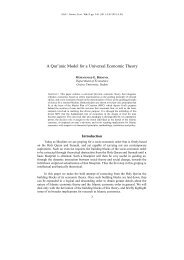An Investigation of the Influences of Particle Size, Size Gradation ...
An Investigation of the Influences of Particle Size, Size Gradation ...
An Investigation of the Influences of Particle Size, Size Gradation ...
Create successful ePaper yourself
Turn your PDF publications into a flip-book with our unique Google optimized e-Paper software.
JKAU: Eng. Sci., Vol. 2, pp. 65-79 (1410 A.H. 11990 A.D.)<br />
<strong>An</strong> <strong>Investigation</strong> <strong>of</strong> <strong>the</strong> <strong>Influences</strong> <strong>of</strong> <strong>Particle</strong> <strong>Size</strong>,<br />
<strong>Size</strong> <strong>Gradation</strong> and <strong>Particle</strong> Shape on <strong>the</strong> Shear Strength<br />
and Packing Behavior <strong>of</strong> Beach Sands in Saudi Arabia<br />
A YAD A. ALZAYDI<br />
Civil Engineering Department, Faculty <strong>of</strong>Engineering,<br />
King Abdulaziz University, Jeddah, Saudi Arabia.<br />
ABSTRACT. This investigation is a study <strong>of</strong> <strong>the</strong> shear strength and packing<br />
behavior <strong>of</strong> Dammam and Abhur Beach Sands in Saudi Arabia in terms <strong>of</strong><br />
<strong>the</strong> geometric particle characteristics <strong>of</strong> size and shape. A large number <strong>of</strong><br />
uniform size sands and a limited number <strong>of</strong> improved gradations are<br />
studied. <strong>Particle</strong> size is defined by mechanical sieving and particle shape is<br />
quantified in terms <strong>of</strong> sphericity and roundness. Surface texture is recognized<br />
to be a significant variable as is particle mineralogy. Packing behavior<br />
is studied with respect to <strong>the</strong> maximum and minimum limiting void ratios<br />
and void ratio spreads. Shear resistance is investigated in terms <strong>of</strong><strong>the</strong> angle<br />
<strong>of</strong> internal friction. Results indicate that both packing behavior and shear<br />
behavior are influenced significantly by particle roundness and surface texture.<br />
The uniform sands tested were normalized into a linear strength-packing-shape<br />
relationship at a given relative density. Chal).ges in grading affect<br />
packing behavior more than strength behavior and <strong>the</strong> normalizations are<br />
ra<strong>the</strong>r sensitive to changes in void ratio spread. Normalizations appear significant<br />
in that <strong>the</strong>y include surface texture variations and afford a possible<br />
technique for a more comprehensive approach to sand behavioral formulation<br />
in terms <strong>of</strong> <strong>the</strong> variables <strong>of</strong> particle size, size gradation, shape, surface<br />
texture, mineralogy and relative density_<br />
Introduction<br />
In <strong>the</strong> field <strong>of</strong>geotechnical engineering, <strong>the</strong> behavior <strong>of</strong>sands is dependent on quantities<br />
and characteristics such as relative density, confinement, particle size, particle<br />
size distribution, particle shape, surface texture, mineralogy, and type <strong>of</strong> test conducted<br />
to determine sand response[I- 4 1. Given a particular type <strong>of</strong>test in which; ideally,<br />
relative density and confinement can be controlled, <strong>the</strong> behavior <strong>of</strong>a given sand<br />
will <strong>the</strong>n depend on <strong>the</strong> above sand characteristics. If it were possible to evaluate<br />
65
66<br />
<strong>the</strong>se characteristics for a given sand, it is conceivable that its behavior could be predicted<br />
ifsufficient test resulls in terms <strong>of</strong> all quantities and characteristics were available<br />
to eSlablish functional relationships. Thus. in order to differcnliale one sand<br />
from ano<strong>the</strong>r. a system <strong>of</strong>designating particle size, panicle size distribution. particle<br />
shape and surface texture is necessary.<br />
Panicle size and size distribution are reproducible by <strong>the</strong> common sieve analysis.<br />
However. a close look al any <strong>of</strong> <strong>the</strong> specific groups obtained by sieve analysis will reveal<br />
thai no two particles arc exactly alike in shape or surface texturels.6l. Hence.<br />
shape and texture can playa major role in <strong>the</strong> behavior <strong>of</strong> particulate materials.<br />
Waddell7.81 showed that particle shape essentially consisted <strong>of</strong> two distinct characteristics.<br />
sphericity and roundness. Sphericity. after Krumbeinl'll. is <strong>the</strong> ratio <strong>of</strong> <strong>the</strong><br />
volume <strong>of</strong> <strong>the</strong> panicle to <strong>the</strong> volume <strong>of</strong> <strong>the</strong> smallest circumscribing sphere. Perfect<br />
sphericity (perfect circularity in two dimensional views) gives a ratio <strong>of</strong> 1.0. Roundness<br />
is <strong>the</strong> ratio <strong>of</strong> <strong>the</strong> curvature <strong>of</strong> <strong>the</strong> corners and edges <strong>of</strong><strong>the</strong> particle to <strong>the</strong> average<br />
curvature <strong>of</strong> <strong>the</strong> particle. A particle which gives a perfect circle as a projection<br />
has a roundness <strong>of</strong> 1.0. It will be shown thai any given sieve portion <strong>of</strong>any sand does<br />
not have singular values <strong>of</strong> sphericity and roundness but ra<strong>the</strong>r has distributions <strong>of</strong><br />
each. Therefore, in order to study sands realistically. <strong>the</strong> behavioral variations <strong>of</strong>different<br />
size ranges must be studied first and compared in terms <strong>of</strong> particles shape and<br />
texture to formulate sand behavior in terms <strong>of</strong> <strong>the</strong>se characteristics.<br />
Surface texture <strong>of</strong>sand grains is an extremely difficult propeny to formulate. if not<br />
an impossible one. The magnitudes <strong>of</strong> <strong>the</strong> surface features allributable to surface<br />
tcxture are subordinate in size to those features included in particle shapedetermination.<br />
For agiven particle size. size distribution and particle shape. surface texture can<br />
be defined only in terms <strong>of</strong> its effects on sand behavior.<br />
<strong>An</strong>o<strong>the</strong>r property <strong>of</strong> sands is <strong>the</strong> mineralogy. It is important since (I) absolute tlensity<br />
in terms <strong>of</strong>specific gravity depends on <strong>the</strong> relative contributions <strong>of</strong> <strong>the</strong> various<br />
mincmls comprising <strong>the</strong> sand particles. (2) tendencies <strong>of</strong>different minerals to cleave<br />
and/or fracture in different ways and <strong>the</strong> geological history <strong>of</strong> each particle influence<br />
<strong>the</strong> sh:lpe and textural features <strong>of</strong> <strong>the</strong> particles, and (3) grain-to-grain frictional<br />
phenomena arc influenced by <strong>the</strong> Iypes and relative amounts <strong>of</strong> <strong>the</strong> various minerals<br />
involved.<br />
It is intended to determine. as far as possible, <strong>the</strong> relative order <strong>of</strong> magnitude <strong>of</strong><br />
<strong>the</strong> influences <strong>of</strong> particle size, particle size gradation, particle shape and surface texture<br />
on <strong>the</strong> behavioral response <strong>of</strong> sand, to determine <strong>the</strong> significance <strong>of</strong> each <strong>of</strong><br />
<strong>the</strong>se characteristics on such response. to seek possible correlations among <strong>the</strong>m,<br />
and to establish <strong>the</strong> feasibility <strong>of</strong> such an approach to sand behavior. This investiga·<br />
tion is not concerned with information on panjcle formation, its interest is only in <strong>the</strong><br />
geometries and surface features <strong>of</strong> panicles as <strong>the</strong>y exist at present in nature. However.<br />
<strong>the</strong> study will assist <strong>the</strong> reader in understanding <strong>the</strong> complexity <strong>of</strong> any attempt<br />
to accurately describe a grain <strong>of</strong> sand.
0<br />
11$<br />
0.62<br />
<strong>An</strong> Invulig~liono{tlte /npuenuso{ P~Ttic/t<strong>Size</strong>...<br />
67<br />
Sand Properties<br />
Laboratory <strong>Investigation</strong><br />
The materials studied in this investigation were derived from three sands obtained<br />
from Ottawa (USA). Dammam Beach on <strong>the</strong> eastern coast. and Abhur Beach on <strong>the</strong><br />
western coast <strong>of</strong> <strong>the</strong> Kingdom <strong>of</strong> Saudi Arabia. Sands were sieved into several uniform<br />
sizes with a uniformity coefficient. Cu' <strong>of</strong> 1.2.<br />
Mechanical sieving. though artificial in nature, isan adequate classification test for<br />
defining uniform particle size ranges and uniform size gradation in terms <strong>of</strong> <strong>the</strong> uniformity<br />
coefficient. however this coefficient is generally inadequate for describing<br />
particle size gradations. The range <strong>of</strong> particle size investigated extended from<br />
O.84mm (No. 20) to O.lOmm (No. 140). plus two special mixes I and 2 as shown in<br />
Table I.<br />
TABl.E I. Materlalsinvestigated<br />
u.s. Sin<strong>of</strong> MeanSh.Valucs. Void Ralio Pol'O:lit)' FllClion <strong>An</strong>~Ic" >. -<br />
~ Sieve Spo<strong>of</strong>.<br />
~ning<br />
So,<br />
Round· Gnll'it),<br />
(11m)<br />
" ""'. ... ...<br />
cil)·· ~' '- '- " I" 1'1 I" '" ""'"<br />
.,.." ,.~ ,.~<br />
lJJ." I.'" 0.768 0..162 ,.""<br />
• 4J.~ 31.6 11.8 379 1.1<br />
3545 500-355 ,.~ D~ 2.66 0.821 00478 0.3·13 a5.1 32.3 12.8 '" 32.9 ~A 1.1<br />
.s .'W ,.• ~211 0.52 2.66 ,.... 0.5.18 '.J» 47.0 ~, 125 31.7 ~, I.l<br />
10-100 212·150 O.~ ,~<br />
I.'" 0.915 0.537 0.3711 aU ~., 12.9 32.3 39.2 1.2<br />
IlkI-JoIO 15(l.1~ ,.~ ,.~ I.'" o.m 0.535 0."" aU ~, 12.9 32.5 39.0 1.1<br />
•<br />
"."<br />
.,.." O.~ D.M I.W 0.", 0.'" "00 ~.• ~.1 10.1 )2.1 ~7j I.l<br />
nAS l
68 Ayad A. AJzaydi<br />
Dammam Beach sands are found to be primarily quartz as shown in Table 2, very<br />
pale brown and appear rounded to subrounded to <strong>the</strong> naked eye. The carbonate percentage<br />
for size 20-30 is 5 percent with little or no heavy minerals. The percentages <strong>of</strong><br />
carbonate and heavy minerals increase as sieve size decreases to reach 19.5 and 4.5<br />
percent for size 100-140, respectively.<br />
TABLE 2. Minerals <strong>of</strong> <strong>the</strong> investigated sands.<br />
-0<br />
c<br />
Sieve Carbonate Quartz<br />
CIl <strong>Size</strong> (%) (%)<br />
'"<br />
Heavy<br />
Minerals<br />
(%)<br />
20- 30 5.1 94.9 -<br />
~.= 35- 45 7.5 92.5 -<br />
e u<br />
e ~ 60- 70 10.2 88.6 1.2<br />
"'~<br />
Cl 70-100 14.2 82.6 3.2<br />
100-140 19.5 76.1 4.5<br />
20- 30 88.4 11.1 0.5<br />
... .=<br />
:3 u<br />
35- 45 67.7 30.8 1.5<br />
.0 .= '" Q) 60- 70 62.4<br />
34.9 2.7<br />
<strong>An</strong> <strong>Investigation</strong> <strong>of</strong><strong>the</strong> <strong>Influences</strong> <strong>of</strong> <strong>Particle</strong> <strong>Size</strong>... 69<br />
70<br />
60<br />
70-100 Oommom<br />
R meon= 0.48<br />
~_. .-<br />
50f--- -<br />
"""§<br />
z<br />
40f---- e-<br />
30 -<br />
20<br />
--<br />
10<br />
r .,<br />
o 05 1.0<br />
Roundness J R<br />
20 7O-100Dammom<br />
15 .. meon=O.79<br />
10<br />
5<br />
OL,-,,--'=---L~~------,~-------;;-::;------==?;;;,---J<br />
0.55<br />
SpheriCity.<br />
'"<br />
FIG. I. Histograms <strong>of</strong> sphericity and roundness <strong>of</strong>70-100 Dammam Beach sand.<br />
Limiting Densities and Shear Resistance<br />
The behavioral response was investigated in terms <strong>of</strong> limiting absolute densities<br />
(packing behavior). Loose specimens were prepared similar to ASTM 02049 by<br />
placing a glass funnel <strong>of</strong> 953mm stem and 7.6mm inside diameter, into 654mm mold,<br />
and pouring <strong>the</strong> sand in a steady stream and spiral motion while at <strong>the</strong> same time adjusting<br />
<strong>the</strong> free fall to 25mm. The top was <strong>the</strong>n carefully levelled with a s<strong>of</strong>t brush.<br />
Dense specimens were prepared by emplacing <strong>the</strong> sand in three equal layers in a<br />
60mm x60mm shear box. Each layer was tapped 50 times by 6mm diameter glass rod<br />
and vibrated for 8 minutes under a surcharge load <strong>of</strong> 0.036 kg/cm 2 . Both loose and<br />
dense specimen preparation techniques were found to be consistent and reproducible<br />
within reasonable limits.<br />
The shear resistance is investigated in terms <strong>of</strong> <strong>the</strong> angle <strong>of</strong> internal friction obtained<br />
from testing 60mm x 60 mm specimens in <strong>the</strong> direct shear box. The limiting<br />
void ratios, porosities, void ratio spread, porosity spread, and <strong>the</strong> angle <strong>of</strong> internal<br />
friction for loose and dense specimens for all sieve sizes are given in Table 1.
70 Ayad A. Alzaydi<br />
TABLE 3. Typical test data for shape determinations <strong>of</strong> (70-100) Dammam beach sand.<br />
Grain<br />
No.<br />
Group 1 Group 2 Group 3 Group 4<br />
I/I-R I/I-R I/I-R I/I-R<br />
1. 0.83 0.50 0.83 0.50 0.81 0.40 0.84 0.50<br />
2. 0.79 0.50 0.74 0.50 0.79 0.45 0.72 0.50<br />
3. 0.73 0.40 0.79 0.45 0.93 0.60 0.87 0.50<br />
4. 0.81 0.45 0.80 0.50 0.87 0.55 0.85 0.45<br />
5. 0.73 0.45 0.77 0.55 0.49 0.45 0.77 0.55<br />
6. 0.83 0.50 0.79 0.50 0.71 0.45 0.88 0.55<br />
7. 0.74 0.50 0.77 0.40 0.72 0.50 0.74 0.50<br />
8. 0.76 0.40 0.79 0.50 0.89 0.50 0.73 0.45<br />
9. 0.67 0.50 0.75 0.50 0.78 0.45 0.70 0.50<br />
10. 0.77 0.50 0.79 0.30 0.84 0.50 0.87 0.55<br />
11. 0.83 0.30 0.79 0.50 0.76 0.45 0.72 0.45<br />
12. 0.83 0.30 0.79 0.50 0.81 0.50 0.76 0.50<br />
13. 0.83 0.50 0.73 0.45 0.85 0.55 0.88 0.60<br />
14. 0.73 0.50 0.85 0.50 0.76 0.50 0.79 0.55<br />
15. 0.67 0.50 0.77 0.55 0.83 0.55 0.71 0.50<br />
16. 0.73 0.50 0.77 0.50 0.77 0.50 0.83 0.55<br />
17. 0.75 0.45 0.87 0.50 0.77 0.55 0.79 0.45<br />
18. 0.83 0.60 0.81 0.50 0.87 0.55 0.79 0.45<br />
19. 0.81 0.50 0.85 0.50 0.83 0.45 0.75 0.45<br />
20. 0.077 0.50 0.81 0.30 0.81 0.50 0.78 0.55<br />
21. 0.83 0.50 0.77 0.55 0.63 0.500 0.70 0.55<br />
22. 0.89 0.50 0.80 0.40 0.82 0.50 0.82 0.50<br />
23. 0.91 0.60 0.83 0.45 0.84 0.50 0.85 0.45<br />
24. 0.69 0.45 0.64 0.45 0.71 0.55 0.77 0.45<br />
25. 0.83 0.45 0.83 0.45 0.73 0.50 0.74 0.50<br />
Sum 19.59 11.85 19.68 11.8 19.72 12.5 19.65 12.25<br />
Mean 0.78 0.47 0.79 0.47 0.79 0.5 0.79 0.49<br />
Standard<br />
Deviation<br />
0.063 0.069 0.046 0.064 0.077 0.045 0.059 0.044<br />
For 100 Grains Tested: I/I mean = 0.79 R",ean = 0.48<br />
Discussion<br />
Values <strong>of</strong> mean roundness ranged from 0.65 (well rounded, 20-30 Ottawa and<br />
Dammam Beach) to 0.47 (subrounded, 100-140 Dammam Beach) which represents<br />
a significant range as shown in Figure 2. The larger <strong>the</strong> particle size, <strong>the</strong> more<br />
rounded it tends to become through natural processes. Since <strong>the</strong> average sphericities<br />
ranged only from 0.79 to 0.87 for <strong>the</strong> sands tested, sphericity was not considered a<br />
primary variable in this investigation.
All Illvestigation <strong>of</strong> 11t~ Illpuellces <strong>of</strong> <strong>Particle</strong> iu...<br />
71<br />
o 70,~-.------------------------,<br />
065<br />
II<<br />
~O.60<br />
~ 0.55<br />
"o<br />
II< o.~<br />
• "".w Sand<br />
'\SI Oommam Beach Son~<br />
o AbhUl' StaCh Sond<br />
0'\5<br />
~<br />
090<br />
• •<br />
50<br />
46<br />
46<br />
44<br />
11-<br />
42<br />
c'<br />
!!<br />
40<br />
u<br />
~ 36<br />
0<br />
t 36<br />
E:<br />
34<br />
'0 .,<br />
32<br />
'" c
72 Ayad A. Alzaydi<br />
0.45 • Ottawa Sand<br />
II)<br />
<strong>An</strong> <strong>Investigation</strong> <strong>of</strong><strong>the</strong> <strong>Influences</strong> <strong>of</strong><strong>Particle</strong> <strong>Size</strong>... 73<br />
0.45<br />
CIl 0.40<br />
Fl(l 5. Smuo<strong>the</strong>rsurface leKluTc or(35-45) D,lmm,lm Belich Slind in A .B_ and C. compared 10 <strong>the</strong> surface<br />
lexture <strong>of</strong> (35-45) Abhur Beach sand in D.E. and F. Scale is in j.l.m.
Flo 6. Smoo<strong>the</strong>r surface texlUre or (70-100) Dammam Ikach sand in A,B, and C, compared 10 <strong>the</strong> surface<br />
texture<strong>of</strong>(70-IOO) Abhur Beach sand in D.E, and F. Scale is in I/om.
76 Ayad A. Alzaydi<br />
Strength behavior in terms <strong>of</strong> <strong>the</strong> angle <strong>of</strong> internal friction increases significantly<br />
with <strong>the</strong> increase <strong>of</strong> particle roundness and size for Dammam and Abhur Beach<br />
sands as shown in Figures 2 and 7. However, <strong>the</strong> influences <strong>of</strong>particle size on Ottawa<br />
sand strength response were indeterminate ei<strong>the</strong>r because <strong>the</strong>y are small compared<br />
to <strong>the</strong> influences <strong>of</strong> particle shape and were masked by scatter or because <strong>the</strong> ranges<br />
<strong>of</strong> particle size investigated were limited (which is doubtful since <strong>the</strong> sands tested<br />
ranged from fine to medium coarse according to M.LT. classification). Improved<br />
particle size gradation represented by Mixes 1 and 2 in Table 1 results in reduced<br />
packing limits and reduced void ratio spreads. Conversely, its influence on strength<br />
behavior is minor as compared to roundness and surface texture.<br />
~o<br />
u<br />
;:<br />
...<br />
a<br />
::<br />
.!! 40<br />
'0<br />
~ r<br />
"c.<br />
c:<br />
<strong>An</strong> <strong>Investigation</strong> <strong>of</strong><strong>the</strong> <strong>Influences</strong> <strong>of</strong> <strong>Particle</strong> <strong>Size</strong>... 77<br />
Qualitative appraisals <strong>of</strong> surface texture are inadequate for behavioral description.<br />
<strong>An</strong> investigation <strong>of</strong> texture requires control <strong>of</strong> particle size, shape and mineralogy.<br />
Hence, <strong>the</strong> fact that particle roundness and surface texture packing behavior<br />
and strength behavior <strong>of</strong> <strong>the</strong> sands tested led to <strong>the</strong> process <strong>of</strong> dividing
:'. <strong>Particle</strong> mineralogy significanlly influences 51 rengt h behavior. but it has liltle or<br />
.lll effect on p'lcking hchavior. Hence. a study <strong>of</strong> sand behavior based on such a<br />
characteristic. wilhout recourse to particle shape information. can only lead to con<br />
Iradictions <strong>of</strong> response. Consideration must be given 10 all <strong>of</strong> <strong>the</strong> above particle<br />
characteristics in order 10 ,'alidly atlribute a particular effect to anyone <strong>of</strong> <strong>the</strong>m. The<br />
importance <strong>of</strong> particle roundness in <strong>the</strong> preSClll investigation intimates that particle<br />
roundness should influence <strong>the</strong> measurement <strong>of</strong><strong>the</strong> particle-Io-panicle mineral friction<br />
char••cteristic.<br />
6. Normalizations <strong>of</strong> <strong>the</strong> 'Ioove phenomena in terms <strong>of</strong> <strong>the</strong> ratio <strong>of</strong> <strong>the</strong> friction<br />
angle to <strong>the</strong> void ratio spre.td as a function <strong>of</strong> roundness arc <strong>of</strong>significanl value in expressing<br />
strength·p:lcking-shapc interrelationships. This normalized form <strong>of</strong> representation<br />
is independent <strong>of</strong>surface texture but is a function <strong>of</strong> particle mineralogy.<br />
rel:lIive density. and particle size gradation.<br />
111 Oda. I'll •• Kooishi. J. and Nrmat_Naswr. S.• Some Experimentally Based Fundamental Resulboo tlK'<br />
Medlanical Behaviour <strong>of</strong>Granular Mall:rials. Gr<strong>of</strong>tchniq,~. 30(4): 47'9-495 (1980).<br />
III Nrmal·Naswr. S.• 00 Bchayjor <strong>of</strong> Granular Materials in Simple SlK'ar. iupuntsr Sociny v/ So.J<br />
Mtchunksund FOlUldu/iQfl Engintffing. 20(3): (1980).<br />
131 Chrisl<strong>of</strong>1'uwn. J .• l'\IehntNodi.1'\1. and Nemat·NlIssu. S.• A Micr<strong>of</strong>fi('ehankal DescriIXion <strong>of</strong> Gr;onular<br />
Material Behavior, i. 0/Applitd Mechanics. 43(2): (1981).<br />
141 Oda. I'll.• Nrmat-N..-r. S. and Mrhrabadi. I'll .• A Stalistical Study <strong>of</strong> Fahric in a Random Assembly<br />
<strong>of</strong> Spherical Granules. Jm. i. for Numtrieul and <strong>An</strong>oJy,ical Mrfhods in GtOmn:hanta. 6: 77·94<br />
(19~).<br />
151 tarkrno.·. A.K .. Methods <strong>of</strong> Stud)'ing Se,1 Strueture. Amerind Publishing Co., N. Y. (1971).<br />
[61 Mitfhdl. J.K.• Fundamentals <strong>of</strong>Soil Behavior, John Wiley and Sons. loc.. N. Y. (1976).<br />
171 Wadrll. II .. Volume. Shape and Roundness <strong>of</strong> Roek Partieles. i. o/Geology. 40: 443-451 (1'132).<br />
[81 Waddl, H.. Volume. Shape and Roundness <strong>of</strong>Ouanz Partides.i. o/Gta/ogy. 43: 250-280(1935).<br />
I'll Krumbfln, W.C.• Measurement and Gl.'nlog,eal Sigmficanl"f: or Shape and Roundlless <strong>of</strong> ScdimentMy<br />
<strong>Particle</strong>s. i. <strong>of</strong>Stdimtn/QfY Pt'(folog)'. II: 64-12 (194 I).<br />
1101 RiIl~nhouw. G., A Visual Method or Estimating Two Dimensional Sphericity.i. o/St'dimm/<strong>of</strong>." 1'1'/.<br />
f/J/Ogy. 13: N·Rl (1943).
<strong>An</strong> <strong>Investigation</strong> <strong>of</strong><strong>the</strong> <strong>Influences</strong> <strong>of</strong> <strong>Particle</strong> <strong>Size</strong>... 79<br />
~I GJ~ ~ ~J • ~\ ~)...wJ • u~1 ~ ~t; L....\),)<br />
~.)~\ ~.rJ1 &J.\ J J-->-irJl JL.) L?~I -.j~G<br />
,=,~)1 ~I ~ ~4i<br />
j.,yJ\ ~ ~\ ......\:0:- , .......J.:J.\ ~ , ~.ll\ .......J.:J,\ ~<br />
~~y-I\ ~.rJ\ ~\ , o..L.-=>:-<br />
.j iL...uG ~f J>-Ir JL.) i..?.r.--=J\ -.j./,...:.11., ~I ....)\.i. --"I)~ ~I i~<br />
j'.& ~...l&- .... \)~ -:..J..li) . ~) w~1 ~ -JI<br />
...,......; f Js- C:L..:JI ...:.J~ ..Lib<br />
Jl .......,.....,al 4.l2::l1 JL.)I .i..J;\.:... -:..J ~ . ~I ~IJ w~1 i)..L.:.....~<br />
,)t Js- c:U1 ...:.J, \c5) . ~I ;.;l;SJ\ ~ ~\) ~I) .....)L:J.I .:..'" ;.,.la.>




